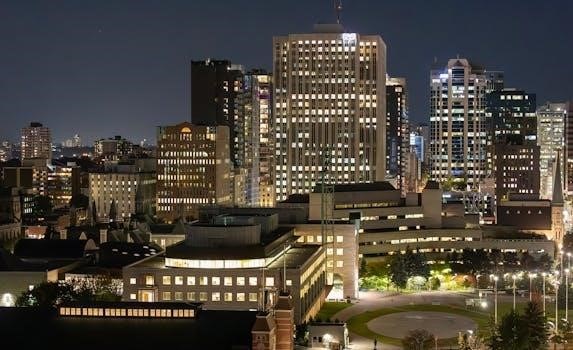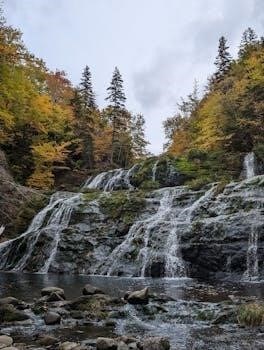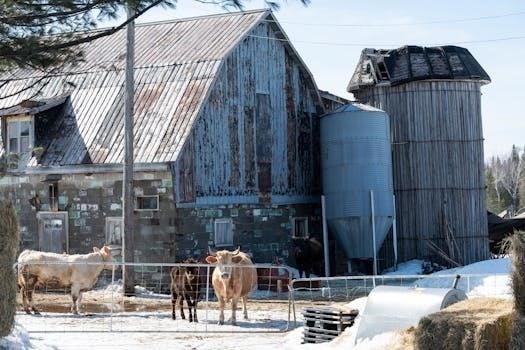Canada is composed of ten provinces and three territories‚ each with its own unique capital. Understanding these divisions is crucial for grasping Canada’s political and geographical landscape. Knowing the capitals is essential for both residents and visitors.
Overview of Canada’s Political Divisions
Canada’s political structure is a federation‚ consisting of ten provinces and three territories. The provinces‚ located primarily in the southern part of the country‚ possess a higher degree of autonomy and are responsible for various areas such as healthcare and education. They extend from the Atlantic Ocean in the east to the Pacific Ocean in the west. The territories‚ on the other hand‚ are situated in the north‚ closer to the Arctic Circle‚ and have less autonomy compared to the provinces. The provinces are often more populated and economically developed‚ while the territories have a lower population density and unique cultural characteristics. This division reflects Canada’s vast geographical diversity and historical development. Each province and territory has its own capital city‚ reflecting the decentralised nature of Canadian governance. Canada’s federal system divides powers between the national government and the provincial and territorial governments. This system allows for regional diversity and ensures that the specific needs of each region are addressed within the framework of a unified nation.
Importance of Knowing Provinces and Capitals
Knowing Canada’s provinces and their respective capitals is fundamental for numerous reasons. Firstly‚ it enhances geographical literacy‚ allowing individuals to understand the spatial arrangement of the country and its diverse regions. Secondly‚ it fosters a deeper comprehension of Canada’s political system‚ recognizing that each province and territory has its unique governance structures and responsibilities. For students‚ this knowledge is often part of the curriculum‚ essential for academic success. Furthermore‚ understanding provinces and capitals is vital for travel planning‚ as it allows people to navigate the country effectively. Knowing the capitals also helps in appreciating the cultural and historical aspects of each region. Each capital city reflects the distinct identity of its province or territory‚ serving as centres of history‚ culture and governance. For new immigrants‚ this knowledge aids in settling in and integrating into Canadian society. In short‚ knowing Canada’s provinces and capitals is more than just memorizing names; it is about understanding the very fabric of the nation.

Provinces of Canada and Their Capitals
Canada’s ten provinces stretch from the Pacific to the Atlantic‚ each with its own capital city. These provinces are key administrative divisions‚ with distinct cultures‚ economies‚ and histories. Understanding them is crucial for knowing Canada.
List of Provinces from West to East
Canada’s provinces‚ when viewed from west to east‚ present a diverse geographical and cultural tapestry. Starting on the Pacific coast‚ we encounter British Columbia‚ known for its stunning natural beauty and its capital‚ Victoria. Moving eastward‚ we find Alberta‚ a province famed for its oil sands and majestic Rocky Mountains‚ with Edmonton as its capital. Next is Saskatchewan‚ a prairie province known for its vast farmlands‚ where Regina serves as its capital. Continuing east is Manitoba‚ another prairie province‚ with its capital in Winnipeg. Then comes Ontario‚ the most populous province‚ with Toronto as its capital‚ though Ottawa serves as the national capital. Further east is Quebec‚ unique for its French language and culture‚ with Quebec City as its capital. The maritime provinces include New Brunswick‚ with Fredericton as its capital; Nova Scotia‚ with Halifax as its capital; and Prince Edward Island‚ the smallest province‚ with Charlottetown as its capital. Finally‚ Newfoundland and Labrador‚ situated in the easternmost part of the country‚ with St. John’s as its capital. This west-to-east progression reveals the vastness and diversity of Canada.
British Columbia and Victoria
British Columbia‚ Canada’s westernmost province‚ is renowned for its breathtaking natural beauty. Characterized by rugged coastlines‚ towering mountains‚ and lush rainforests‚ it is a haven for outdoor enthusiasts. The capital city‚ Victoria‚ is situated on the southern tip of Vancouver Island. Victoria is known for its charming British colonial architecture‚ beautiful gardens‚ and a relaxed pace of life. While Vancouver is the largest city in the province‚ Victoria retains its distinct character and historical significance as the provincial capital. Victoria offers a variety of attractions‚ including the iconic Inner Harbour‚ the historic Empress Hotel‚ and the scenic Butchart Gardens. The city also serves as a major center for government‚ education‚ and tourism. British Columbia’s diverse landscape and vibrant cities‚ with Victoria at its heart‚ make it a unique and captivating part of Canada. The province is a major draw for both tourists and new residents‚ thanks to its combination of urban and natural attractions.
Alberta and Edmonton
Alberta‚ a province known for its vast prairies‚ stunning Rocky Mountains‚ and rich energy resources‚ is a key player in Canada’s economy. Its capital city‚ Edmonton‚ is located on the North Saskatchewan River and is the most northerly of Canada’s provincial capitals. Edmonton is a vibrant city that boasts a thriving arts and culture scene‚ numerous festivals‚ and a diverse culinary landscape. Despite Calgary being the largest city in the province‚ Edmonton holds the distinction of being the seat of government and a major hub for commerce and education. The city is also home to the largest urban park in Canada‚ offering a wide range of recreational activities. Edmonton is not only a significant administrative center but also a dynamic and growing city with a unique charm that attracts both residents and tourists. The city’s northern location gives it a distinctive character. Edmonton combines its role as a capital with a spirited urban culture.
Quebec and Quebec City

Quebec‚ the largest province in Canada by area‚ holds a unique place in the country’s history and culture‚ with French as its official language. Its capital‚ Quebec City‚ is one of the oldest and most historically significant cities in North America‚ boasting a rich heritage evident in its architecture and cultural traditions. The city is a UNESCO World Heritage site‚ renowned for its well-preserved fortifications‚ charming cobblestone streets‚ and the iconic Château Frontenac. While Montreal is the province’s largest city and a major economic hub‚ Quebec City retains its status as the political and administrative center. Quebec City is nestled along the Saint Lawrence River. The city’s distinct European ambiance and its deep French roots set it apart from other Canadian capitals. Its cultural significance and historic charm make it a popular tourist destination. Quebec City combines old-world allure with modern urban life. The city reflects Quebec’s unique identity.

Territories of Canada and Their Capitals
Canada also includes three territories⁚ Yukon‚ Northwest Territories‚ and Nunavut. These territories are located in the northern part of Canada. They have their own capitals and unique characteristics.
Overview of Canadian Territories
Canada’s territories‚ unlike its provinces‚ are not sovereign entities but are under the direct jurisdiction of the federal government. These three territories—Yukon‚ Northwest Territories‚ and Nunavut—occupy the northern reaches of Canada‚ bordering the Arctic Ocean. They are characterized by vast‚ sparsely populated landscapes‚ and often have significant Indigenous populations. The territories differ from the provinces in governance structure and resource management. They are primarily administered by the federal government‚ with some powers devolved to the territorial governments. The territories‚ while sharing some similarities‚ each possess unique histories‚ cultures‚ and geographic characteristics. Their remoteness and harsh climate contribute to their distinct identities within Canada’s broader context. These northern territories are crucial for understanding the diversity of Canadian experiences and landscapes. Recognizing their distinct nature is essential for a comprehensive understanding of Canada.
Yukon and Whitehorse
Yukon‚ one of Canada’s three territories‚ is situated in the northwestern part of the country‚ known for its rugged terrain and subarctic climate. Whitehorse‚ its capital city‚ has held that title since 1953 and is named after the Whitehorse Rapids‚ which resemble the mane of a white horse. The territory itself derives its name from the Loucheaux Native word for “great river‚” Yuchoo. Whitehorse‚ is the largest city in Yukon and acts as a hub for transportation and commerce. The region is sparsely populated but rich in natural resources and has a significant Indigenous history. The territory’s landscapes are dominated by mountains‚ rivers‚ and forests‚ making it a destination for outdoor activities. Yukon’s unique environment is a significant part of Canada’s geographical diversity. It also offers unique cultural experiences‚ highlighting the blend of Indigenous and Western influences.

Additional Information
Canada‚ the second-largest country globally‚ spans 9‚984‚670 square kilometers. It has diverse climate zones‚ from Arctic to temperate‚ and a population distributed across its vast area. The country’s geographical features vary widely.
Canada’s Total Area and Population
Canada boasts a vast total area of approximately 9‚984‚670 square kilometers‚ making it the second-largest country in the world by landmass‚ following Russia. This expansive territory includes diverse landscapes‚ from the rugged coastlines to the majestic mountains and the vast prairies. Despite its enormous size‚ Canada’s population is relatively moderate compared to other large countries. The population is unevenly distributed‚ with the majority concentrated in urban centers near the southern border with the United States. This demographic distribution is largely influenced by the climate and accessibility of various regions. The northern territories are sparsely populated‚ while the southern provinces host most of the population. Understanding the vastness of Canada in relation to its population helps contextualize the challenges and opportunities for both its residents and the government. Canada’s population is primarily concentrated in a few key areas‚ reflecting the country’s unique geographical and climatic realities. The large area and moderate population density create unique considerations for infrastructure‚ resource management‚ and environmental policies.
Geographic Location and Climate Zones
Canada’s geographic location spans from the Pacific Ocean in the west to the Atlantic Ocean in the east‚ and extends northward to the Arctic Ocean. This vast expanse encompasses diverse climate zones‚ ranging from the Arctic tundra in the north to the temperate rainforests on the west coast. The country is generally categorized into six main climate regions. These include the Arctic region‚ characterized by long‚ cold winters and short‚ cool summers; the Boreal region with its extensive forests; the West Coast‚ known for its mild‚ wet climate; the Prairie region with its hot summers and cold winters; the Mountain region‚ featuring a wide range of climates based on altitude; and the Southeastern region‚ with a humid continental climate. Canada’s climate plays a significant role in its population distribution and economic activities. The variation across these regions makes it crucial to understand the specific climate conditions when learning about the provinces and territories. The unique climate zones shape the character and environment of each area.